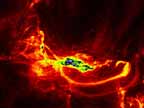Summary of Wave Theory
(Continued —
Page 3)
Printer-Friendly
Version
On its own, energetic matter is a living, mercurial
entity that is given to constant changes in direction. Moreover,
energetic matter is capable of producing similar formations
due to the natural behavior of energetic matter. This stems
from the fact that it moves exclusively along a path that
it created on its own, in accordance with Feynman's idea that
an electron recalls its own route. Since galaxies are neither
produced on the basis of some sort of matrix nor share the
same framework, every galaxy possesses a unique structure.
Consequently, each galaxy offers energetic matter a unique
opportunity. The same logic also explains the vast diversity
within the human species, as no two individuals are truly
identical.
To follow is a gallery of various galactic formations
— the Galactic
Gallery. We see that the energetic matter in young,
highly energetic galaxies is completely transparent, practically
virtual. The dimensions of these galaxies depend on the amount
of energetic matter that they contain and the particular phase
transition they are in. Galaxies maintain a permanent distance
from each other, which varies according to the amount of energetic
matter and gravitation in their source. Moreover, space is
linked to the energetic loops to which they belong. In other
words, the wave formation has borders but the expanse of its
gravitational space is infinite.
The energetic and magnetic loops interact in
what can be termed a spousal relationship involving the synergy
between two perpendicularly-aligned loops with a central swirl
that is located either between, or in each of, the two loops,
depending on the phase transition. The magnetic component
corresponds to the Schwarzschild swirl, while the energetic
portion corresponds to the Kerr swirl. Both components are
in what Erwin Schrödinger referred to as a constant state
of superposition. In some formations, several magnetic loops
emerge from the energetic swirl (picture below, left). The
energetic matter that flows in each loop constantly changes
its configuration.
| |

Click to enlarge (NASA)
|
|
|
From this analysis of the M51 and other galaxies,
I surmised that a quant must similarly be comprised of two
components. When Planck developed his idea of the quant, the
major stumbling block was the absence of an energetic component.
He intuitively solved this problem by formulating his renowned
mathematical equations. However, Wave theory introduces the
notion that even the quant is comprised of two parts (which
calls to mind Paul Dirac's strange idea of two positive and
two negative segments in every state). This dichotomy is illustrated
brilliantly in Schrödinger's notion of superposition
and Werner Heisenberg's Uncertainty Principle.
Back to Top
Dr. Chaim Tejman, Copyright©
2004. All rights reserved.
[Index]
[Introduction]
[Book] [Wave
Formation] [Photons] [Gravitation]
[Time] [Life]
[Cancer] [Fundamental
Force] [Gender/Why Sex?]
[Sexual Reproduction]
[Schrodinger & Heisenberg]
[Creation] [Supernova]
[Dark Matter & Astronomy]
[Speed of Light] [Cloud
Formations] [Natural Disasters]
[Global Warming] [Thermodynamics]
[Backward Time] [Quantum
Mechanics] [Compton Effect]
[Equations] [Predictions]
[Academic Correspondences] [Contact]
[Links] [Mysteries] |